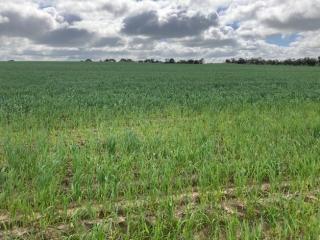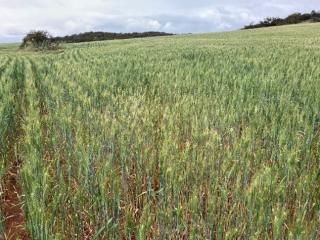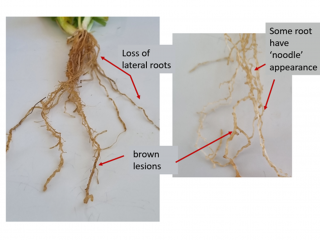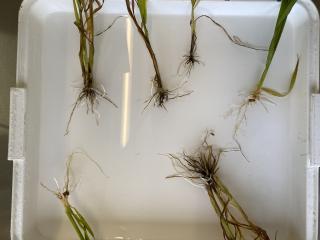Why is my crop patchy? Diagnose soilborne diseases to form strategies for next season
-
Widespread locations across WA grainbelt

Crops with symptoms of soilborne disease and nematode pest issues are being widely reported by Department of Primary Industries and Regional Development (DPIRD) researchers and consultants across the grainbelt. DPIRD’s Diagnostic Laboratory Services (DDLS) team have been receiving samples with suspected nematode, or soilborne pathogens, from paddocks ranging across the grainbelt from Geraldton to Albany. In the Geraldton port zone, patches are particularly noticeable in wheat and barley crops. DPIRD staff are sending multiple plant samples to DDLS and so far, the majority in the northern and eastern grainbelt are testing positive for root lesion nematode (RLN) species Pratylenchus neglectus and rhizoctonia. RLN species P. quasitereoides has also been reported in the central and southern grainbelt.


Earlier this year, preseason molecular testing was conducted in paddocks in Katanning, Dalwallinu, Walebing, Broomehill, Pingelly and Yerecoin infested with root lesion nematodes (RLN) Pratylenchus quasitereoides and P. neglectus. The results revealed medium to very high levels of infestation, which meant yield losses were a possibility in these paddocks in a conducive season if a susceptible crop was sown. For more information on nematode risk categories, refer to the South Australian Research and Development Institute’s Predicta® Research Risk categories fact sheet.
Unfortunately, numerous areas within WA’s grainbelt are experiencing a growing season conducive to yield loss due to RLN impacts. The situation is being worsened by late starting rains combined with environmental conditions that cause plant stress, including waterlogging around Albany, Broomehill, Katanning and Esperance and dry conditions in the northern and central growing areas.
Root lesion nematodes
Nematodes are microscopic worm-like creatures that come in many forms and are important to soil biological structure. Plant parasitic nematodes naturally live and feed on the root systems of plants and most plants can tolerate low levels of plant parasitic nematodes without any ill thrift.
Unfortunately, our monoculture cropping systems in WA often includes susceptible crops. Many growers are choosing to reduce the frequency of break crops (such as lupin) in recent years, and instead are growing predominantly cereal-canola. Canola, wheat and barley are susceptible to root lesion nematode. This can cause plant parasitic nematode numbers to accumulate to high levels (e.g. >25,000 nematodes/gram of root) and result in significant yield reductions.
Refer to DPIRD’s 2023 WA Crop Sowing Guide for nematode resistance classifications for different varieties.
Four species of RLN are commonly found in Western Australia: Pratylenchus neglectus, P. quasitereoides, P. thornei and P. penetrans. Other plant parasitic nematodes that have the potential to cause yield loss in WA include the cereal cyst nematode and the burrowing nematode). Therefore, correct identification of nematode type and species is important because the choice of suitable crop and variety to mitigate future crop damage is dependent on knowing which plant parasitic nematode species are present.
Above ground symptoms of plants infected with root lesion nematodes include stunting, poor growth, plants prone to early wilting and lower leaves turning yellow prematurely and dying back from the tips.

Below-ground symptoms often include poor root systems with sloughing of the root cortex, fewer lateral roots or root hairs compared to nearby healthy plants. Brown/dark coloured lesions along the roots are also common. For more information, refer to DPIRD’s diagnosing root lesion nematodes in cereals page.
Management measures rely on reducing nematode numbers over a period of at least one season by growing less susceptible crop varieties, resistant break crops or employing fallow periods. With high nematode populations, a break of more than one season may be needed.
Common WA weeds can also be susceptible to nematodes. Control of summer weeds and keeping weeds under control in-season in infested paddocks are important management practices.
For more information on nematodes refer to:
- DPIRD’s 2018 Protecting WA Crops Issue 12 root lesion nematode newsletter.
- DPIRD’s root lesion and burrowing nematodes: diagnosis and management page.
- GRDC’s root lesion nematode fact sheet.
Other causes of patches in crops
Patches occurring in cereal crops are not unique to RLN. Other factors contributing to these patches include soilborne diseases such as rhizoctonia and take-all, along with non-disease related factors.
There have been several observations of rhizoctonia across the grainbelt including Corrigin, Hyden, Narembeen, Mingenew and Geraldton.
A few occurrences of take-all have been recorded this season, with one case reported at Lake Grace.
Growers that have confirmed their paddock has rhizoctonia, with large amounts of the crop affected this year, should consider implementing a grass-free break crop such as canola, pulse or pasture in 2024. Canola has been shown to reduce the level of disease in the following cereal crop but it will become a problem again in the second year of cereals. For detailed information about management options for rhizoctonia, read the GRDC's tips and tactics rhizoctonia factsheet.
For take-all, a grass-free non-cereal break will reduce the pathogen significantly.
Patches caused by rhizoctonia or RLN are difficult to distinguish from each other without close inspection of the plant roots. They require further laboratory tests to identify the primary cause of the issue.

In some cases, a combination of diseases and nematodes are responsible.
Paddocks with a history of continual cropping to cereals often also have the worst soilborne disease issues.
Growers that have observed poor patches in their crops this season are urged to diagnose and confirm the issue causing the patches in crops. This will help put the right management plan in place for 2024. Predicta B soil testing does not cover all the nematode species, so in addition to soil testing, submitting plant samples to DPIRD’s Diagnostic Laboratory Services (DDLS) is recommended.
How to send plants to be diagnosed
For diagnosis of root disease or nematode problems in-crop, growers and consultants can carefully dig up symptomatic plants from the edge of the patch (not the centre) as well as healthy plants from outside the patches. The department’s YouTube video how to take a plant sample shows the correct method to use.
Plants can be sent to the department’s Diagnostic Laboratory Services by mailing them to
Department of Primary Industries and Development
Reply Paid 83377
3 Baron-Hay Court
South Perth WA 6151
Upcoming field walks
There are two field walks with presentations on the impact of soil tillage on rhizoctonia coming up. The first is on Monday 11 September in Narembeen, and the second is on Wednesday 13 September at DPIRD’s Wongan Hills Research Station. For more information on these events, contact the host grower group Corrigin Farm Improvement Group or refer to the Liebe Group website.
More information
For more information contact Senior Nematologist Sarah Collins in South Perth on +61 (0)8 9368 3612, Plant Pathologist Daniel Hüberli in South Perth on +61 (0)8 9368 3836 or Research Officer Carla Wilkinson in South Perth on +61 (0)8 9368 3862.
Article authors: Cindy Webster (DPIRD Narrogin), Sarah Collins (DPIRD South Perth) and Daniel Huberli (DPIRD South Perth).
Article input: Ciara Beard (DPIRD Geraldton).

